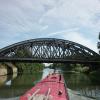
Appleford Railway Bridge

There is a bridge here which takes a railway over the canal.
| Culham Cut Footbridge | 1 mile, 6 furlongs | |
| Culham Lock | 1 mile, 3½ furlongs | |
| Tollgate Road Bridge | 1 mile, 3 furlongs | |
| Culham Lock Weir Exit | 1 mile, 2 furlongs | |
| Didcot Power Station Outlet | 6¾ furlongs | |
| Appleford Railway Bridge | ||
| Clifton Lock Weir Entrance No 2 | 1 mile, ¾ furlongs | |
| Clifton Cut Bridge | 1 mile, 3¾ furlongs | |
| Clifton Lock Short Term Moorings | 1 mile, 5¼ furlongs | |
| Clifton Lock Weir Entrance No 1 | 1 mile, 5¾ furlongs | |
| Clifton Lock | 1 mile, 6 furlongs | |
Amenities here
Why not log in and add some (select "External websites" from the menu (sometimes this is under "Edit"))?
Mouseover for more information or show routes to facility
Nearest water point
In the direction of Teddington Lock Weir Exit
In the direction of Osney Bridge
Nearest rubbish disposal
In the direction of Teddington Lock Weir Exit
In the direction of Osney Bridge
Nearest chemical toilet disposal
In the direction of Teddington Lock Weir Exit
In the direction of Osney Bridge
Nearest place to turn
In the direction of Teddington Lock Weir Exit
In the direction of Osney Bridge
Nearest self-operated pump-out
In the direction of Osney Bridge
Nearest boatyard pump-out
In the direction of Osney Bridge
Wikipedia has a page about Appleford Railway Bridge
Appleford Railway Bridge carries the Cherwell Valley Line from Didcot to Oxford across the River Thames near the village of Appleford-on-Thames, Oxfordshire, England. It crosses the Thames on the reach between Clifton Lock and Culham Lock.
Originally, a timber bridge was built at the approximate location of the present bridge; by December 1843, it was reportedly under construction, and was completed during the following year. By the 1850s, it has been replaced by a more substantial bridge principally composed of wrought iron so that heavier trains could be run along the line. A third bridge was completed in 1927, which was built out of steel; it is this structure that is presently used as of the 2010s.
























![Bridge taking railway over The Thames south of Culham Station. There is an OS flush bracket benchmark [[4317599]] in the sunlit patch on the wall abutting the main bridge structure. A First Great Western Turbo diesel multiple unit passes south over the bridge as a blur. by Roger Templeman – 19 January 2015](https://s0.geograph.org.uk/geophotos/04/31/76/4317600_308d2da5_120x120.jpg)






![Other side of the arch. The other side of the arch under the Appleford rail bridge. [[1420316]] by Bill Nicholls – 05 July 2009](https://s2.geograph.org.uk/geophotos/01/42/03/1420358_e3d42f18_120x120.jpg)